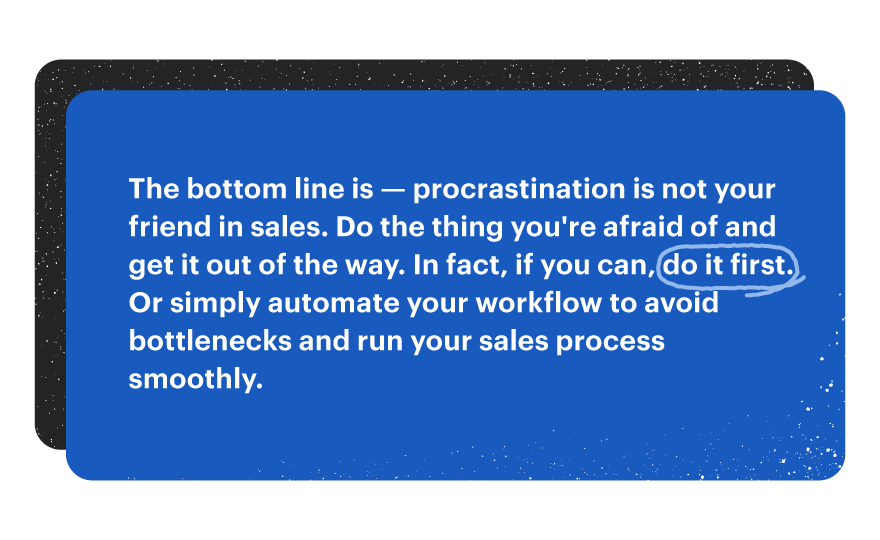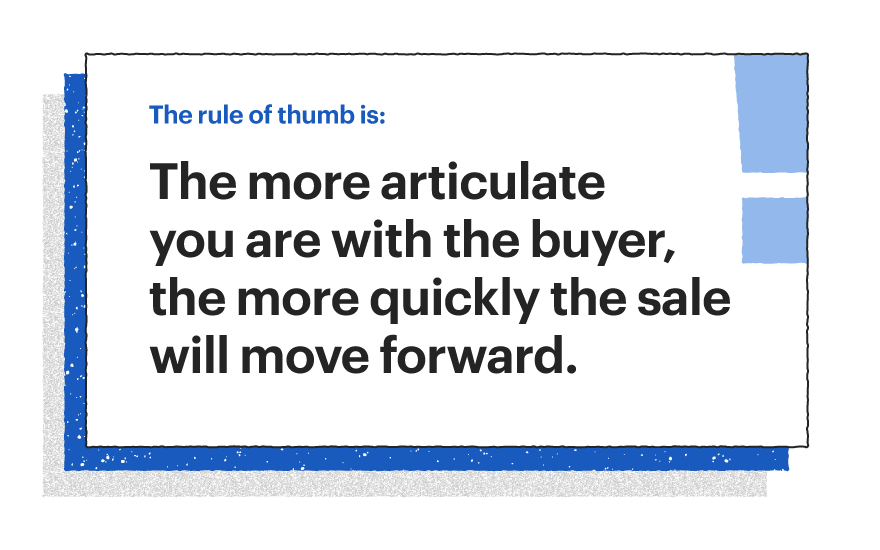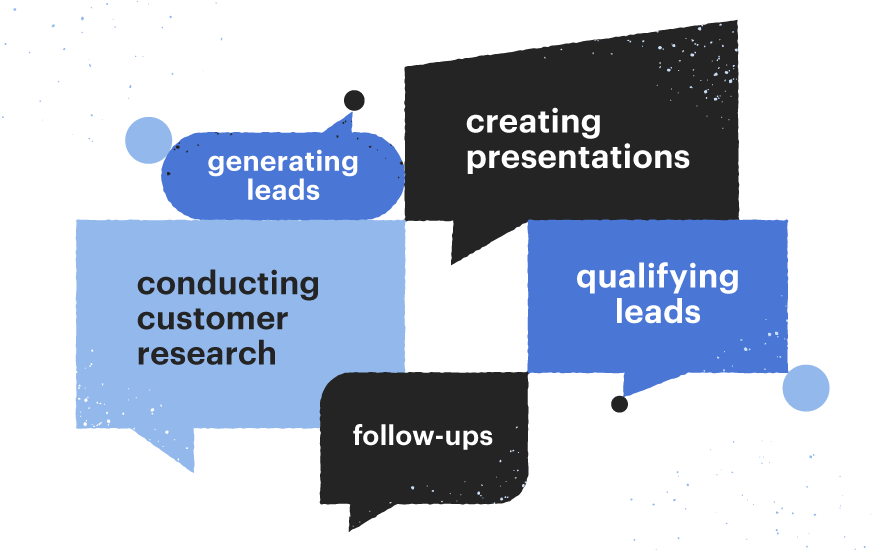“Time is money”, and so it is – especially in the case of salespeople – but, it somehow feels like there’s never enough time in the day for work and daily activities.
Choosing one prospect over another might mean the difference between closing a million-dollar contract and being turned down.
Spending a particular amount of time on one category of activities can set a person up for a record week, whereas focusing on something else can lead to a slump.
One of the most challenging skills for salespeople to acquire is time management in a single workday but on the whole, as well.
At any given time, reps have multiple critical duties vying for their attention. How do they set priorities and make the most of their time?
A few basic time management tricks might help the sales team enhance their productivity without adding extra hours to the day.
Here’s a list of advice you may find effective enough to put your sales errands in order.
01. Try to reduce/eliminate administrative tasks
Look for administrative duties that you can automate to increase your selling time.
Saving a few minutes here and there will quickly mount up. You’ll be able to devote more focus to things that are genuinely challenging, such as delivering demonstrations or answering complex inquiries.
For example, using PandaDoc is an effective solution for your salesforce.
It is, among its other uses, can automate your sales process with its templates, analytics and numerous integrations.
PandaDoc imports data from your CRM, so you don’t have to waste time copying and pasting vital information.
In just a few clicks, you can deliver an error-free, personalized, and professional-looking proposal. What is more, PandaDoc offers a range of fully-customizable sales proposal templates you can use for varying sales purposes.
02. Be ready to re-group
One of the best tricks for outside sales is to categorize your leads by location. In addition, keeping track of the date of your last interaction with each lead also plays a significant role.
Instead of driving back to the office or cooling your heels at a coffee shop until the next appointment, you can quickly regroup and connect with other nearby prospects to get a new meeting.
PandaDoc sales proposal templates can be of great use here – it takes just a few minutes to update your pitch and move on to a new, unplanned meeting.
This strategy can also be used in inside sales. Prospects cancel appointments all the time, so salespeople must be ready to pivot into other profitable activities at any time.
The trick is to keep those activities in the same gear. Let’s say you’re planning an hour-long exploratory conversation and one of your prospects backs out.
Spend that regained hour preparing for other exploratory calls you have scheduled that week since you’re now in the mindset of the exploratory call. Your attention is already drawn to the investigation. Keep it in place.
Some of you are probably thinking to yourselves,
“That’s unreasonable advice; you should prospect or make follow-up calls during that period.” But here’s the thing: there’s a catch.
You’ll probably squander time getting ready to make those calls unless you have your leads available and are fully prepared to prospect.
From our point of view, sales prospecting is a process that is more productive when it is deliberate, planned and scheduled.
This leads us to the following point.
03. Keep your focus, well, in focus
Multitasking is an urban legend.
According to studies, we, as people, cannot accomplish two things simultaneously; we can only move between tasks fast. Because our brains have to adjust to each job, this switching dilutes focus and slows people down.
Distinct tasks employ different mental muscles in the context of sales. Demonstrating, for example, takes a very different mindset and emphasis than pre-call preparation or pipeline management.
Similar activities can be grouped together to help sales staff be more efficient.
Take, for example, prospecting. Let’s imagine your company promotes the use of voicemail and email as crucial components of prospecting, and you’ve set aside two hours to make calls.
One strategy is to call the prospect, get their voicemail, leave a message, compose a follow-up email, send the email, document the action in the CRM, create a new activity to try to reach the prospect again, and then go on to the next prospect on your call list and continue the cycle for two hours.
Because of all the activity switching, this method might eat up a lot of time. There are numerous options for streamlining it.
Grouping activities and prioritizing have proven most effective:
- Calculate how many prospects you could call in two hours if you only dialed the phone and left voicemail messages. It will help if you research prospects before your designated prospecting period.
- Pull up the list of researched prospects you wish to call when it’s time for your two hours of prospecting.
- Based on your pre-call research, call each prospect and leave individualized voicemails. In the CRM, only record the call activity and immediately move on to the next prospect on the list. Repeat.
- Return to the list of prospects you phoned later in the day during the scheduled administrative time to send out the follow-up emails and establish the times you want to contact them again in the CRM.
This simple change in activity grouping will result in a considerably higher volume of calls, increasing your chances of actually speaking with someone on the phone about what you’re offering.
And isn’t that what business development and successful sales time are all about?
04. Just get it out of your way
Every salesperson has at least one task that they absolutely despise — prospecting, keeping track of activity, sending follow-up emails, and so forth.
The odd thing is that we can all come up with a variety of strategies to appear productive while avoiding the activities we loathe the most.
However, if you overinvest in one area to avoid completing work in another, time will fly by. And such behavior always comes back to haunt you in the end when it’s time to talk to your sales managers.

05. Stick with the momentum
When sales reps achieve success or meet an activity goal, they often take a moment to congratulate themselves.
While we’re not opposed to a short coffee run, the most excellent time to call or schedule an appointment is… just after you’ve had a wonderful conversation or scheduled an important meeting.
So, if you’ve set aside a certain amount of time for a particular activity, such as prospecting, don’t stop before the time is up, even if you’re having some success straight away.
With PandaDoc you can set up the process tracking not to lose valuable time.
Momentum has a lot of power. Don’t throw it away after you’ve acquired it. If you just keep going, you’ll have even more reasons to pat yourself on the back.
06. Make the buyer’s needs your focus
The greatest time to connect with prospects, according to experts, is in the afternoon, very early morning, evening, late-mid early morning, or on weekends.
That, as it seems, is all there is to it.
As you are undoubtedly aware, there is no such thing as a perfect time to engage with your ideal customers and complete important tasks.
It all depends on the buyer’s personality and how they allocate time to complete their tasks.
Calling at 10:00 a.m. to sell to contractors isn’t going to work because they’re already on the job site.
Calling a restaurant that does a brisk lunch and supper business afternoon is unlikely to result in a positive interaction.
To prevent wasting time on ignored calls, try to plan your day around the schedule of your target buyer. With PandaDoc you can set automated email reminders not to miss perfect timing.
Having things organized will result in less time wasted and more quotas fulfilled.
07. Streamline repeatable tasks
Although sales scripts may not be a too attractive way to do business, the truth remains that if your business caters to a specific type of buyer, many of your prospects will be similar.
Instead of coming up with a new list of questions every time you speak with a prospect, create a core set that you can work with and customize.
Another good approach is to create a framework for prospect research.
Examine prior deals you’ve won and seek elements that have shown valuable time and time again for your sales process.
For example, in seven of the previous ten deals you concluded, you may have used PandaDoc templates for faster delivery. While you know some other practical ways to do business, you may go straight to them when looking for effective closure time.
08. Create a succinct value proposition
Initiation talks are another place where salespeople can waste time. Your prospect will ask you, “So what do you do, anyway?” at some point during your sales conversation.
You’ll have more time to address the topics that actually matter to your prospects and learn how you can help them if you have clear, concise responses to the frequent questions you get asked every day.
It’s less likely that you’ll stumble through the explanation if you have a clear, well-articulated business proposal on hand.

09. Create a to-do list for the next day the night before
Is preparing everything the night before the key to enviable sales performance? It could be, yes.
When you set goals for the next day before you depart for the night, rather than squandering your busy mornings doing so, you have a clear sales strategy the second you wake up.
This eliminates frustration and leaves you more time to focus on unexpected tasks or even make those extra sales calls you’ve never had the time for.
By organizing the night before, you can get right to work and focus on fulfilling those sales goals you’ve committed to.
Save these tasks for later in the night when you’re exhausted, and make the most of the time you have.
10. Employ the 80/20 rule
The 80/20 Rule states that if you spend 20% of your time on anything, you will get 80% of the outcomes.
Concentrate on the tasks that will have the most impact on your success rather than the ones that will have the least impact. Then, search for ways to outsource or group those activities with a low return on investment.
You can think about the 80/20 rule like this, too: 20% of your consumers will account for 80% of your sales.
That is true for a company, but many salespeople will have names on their list of those who will never buy and others who will become high-value, long-term clients.
The sooner you can qualify, the better; if you’re doing your own qualifying, go hard and fast, batch it, and remember: if you’re on the phone with an unqualified lead, you’re not selling.
Either you’re qualifying, or you’re simply chatting.
11. Create e-mail templates
Writing a new e-mail every time you communicate with a prospect is inefficient and time-consuming.
While you should personalize each message to the individual and their situation, starting with a template rather than a blank slate will save you a lot of time.
Search your“Sent” folder for e-mails that you send frequently and use them to create email templates that will save you time and effort in the long run.
That doesn’t simply apply to outreach e-mails; you should also create templates for follow-up, meeting scheduling, call recaps, and so on.
12. Use the most effective sales tools
To help you with your sales efforts, make sure you have the necessary sales automation tools.
A product can’t sell itself. You’ll need a persuasive presentation, and having a variety of tools can help.
Most salespeople still use PowerPoint, Excel, PDF, and other presentation tools that aren’t ideal in 2021.
While PowerPoint has been around for decades and is familiar to most people, it is far from the greatest presentation software and certainly not the most professional.
More powerful tools allow you to create better-looking interactive presentations that you can customize with a single click. They give you a lot of possibilities for creating dynamic sales content, and they even track your sales deck via email.
So, do some research and find what tools and apps work best for your line of sales and how you can use them to your benefit.
13. Speak your client’s language
One of the main aspects of successful sales deals is knowing how to speak to your customer and anticipating their needs beforehand.
But, what does that mean exactly? It means getting to know your client and speaking to them in a way that they will respond to.
It could mean using examples from their industry or business, discussing their objectives, casually referring to something from their social media platforms, or using their lingo.
You may gain their trust by demonstrating that you care about their needs and make an effort to connect with them.
Because every client is different, using the same story, customer dialogue, and/or static sales deck for each presentation may not get you far.
Templates are fine and desirable, but make sure you modify them to each client to boost your chances of making a sale and increase your overall sales productivity.
14. Take breaks regularly
Taking a five-minute rest between each time block has proven as an efficient way to complete tasks quicker and more accurately.
The logic behind this is that, by taking breaks, we’re allowing our brains to process what we’re working on instead of overcrowding it with information.
A rested brain promotes better workflow, more ideas, and overall sales productivity.
Allow your brain to relax, recoup, and stay fresh by getting up, moving about, going for a little stroll, or grabbing some water.
Sales coaching tips and hacks for sales leaders and sales managers

Assuming the role of a sales manager or sales leader is a huge responsibility, especially if you are head of a big sales team.
Apart from monitoring their performance, you need to be the person they learn from, come to for advice, get the best sales training, and consult on challenging sales activities and/or tasks.
Here’s some advice you can use to keep things under control and help your sales reps be the best at their jobs:
Create a strategy and provide guidance on it
Every salesforce should have a sales strategy and plan in place. The plan should differ depending on the client, but there should be a framework to work with.
A strategy can assist you, and your sales reps to prepare for meetings and make you appear more professional to your customer. Clients like to do business with organizations that are well-organized, structured, and knowledgeable.
Once you’ve developed a plan, you’ll be able to educate new hires on it.
You can integrate your sales strategy with your onboarding or continuous coaching for all salespeople.
It never hurts to go over the basics, methods, goals, or any other aspect of the overall sales approach.
Finally, review the strategy on a regular basis.
It might work at first, but it will need to be tweaked afterward.
Examine previous instances, both those you won and those you lost, to see what went right and what went wrong. Take into account any input you get from your clientele.
It’s critical to learn from your successes and failures to align your strategy with your goals and market realities.
Establish healthy communication within the company
The importance of internal communication in the workplace cannot be overstated.
In all elements of a business, communication is essential.
It’s tempting for salespeople to go out on the road and concentrate only on closing deals and reporting them back to the office.
However, it is critical that they are aware of what is going on in the workplace and vice versa.
The marketing or sales team at the office could assist with the following issues reported by the salespeople we spoke with:
- generating leads
- qualifying leads
- conducting customer research
- creating presentations
- follow-ups
The office personnel may have leads, know which clients to target, bring in higher sales efficiency, assist with presentation preparation, communication management, and client research, among other things.
As a result of combining sales and marketing, communication will be open and fluid, and a company will work more efficiently and smoothly, resulting in more significant results.
Estimate your sales efficiency
Let’s look at a few time management tips you might utilize the sales efficiency ratio to evaluate your team’s efficiency and find ways to spot time wasters that need additional coaching.
1. By time
Sales efficiency can be calculated by year, semester, quarter, month, or any other time. If, say, you give statistics to management on a quarterly basis, that would be the best time to do so.
2. By salesperson or by group
To assess the effectiveness of each staff member, you may calculate the sales efficiency of each individual employee. You might also calculate it at the team level.
It’s also tempting to just look at the total number of agreements closed over time.
However, this isn’t always accurate because each transaction has a different value, and one large sale may generate more money than five small purchases.
3. By speed and agility of sale
You might also look into the speed with which sales are completed, from the time a lead is received to the time they sign a contract.
In the end, the longer a salesman works for a company, the higher the costs of generating a sale grow.
The new normal: Is remote sale affecting sales efficiency?
As we’ve seen, sales efficiency is tightly linked to time management; together, they provide a solid indication of how well the sales department is performing.
Sales do not establish a firm, but they do bring in the clients and money that enable it to operate.
Due to COVID-19, many organizations sent their staff home to limit the chance of infection, which has significantly changed the way we function.
A large number of salespeople who used to work on the road are now selling online via videoconferencing, LinkedIn and other channels. As a result, the importance of inside sales is being redefined.
This has resulted in a reduction in operational costs for many businesses.
The question everyone’s been asking is how to manage time and improve sales efficiency in times like these?
Using dedicated tools like PandaDoc has proven as the best method to improve sales efficiency.
They may appear to be extra costs at first, but considering how much time you save and how much professionalism you gain, they become a no-brainer.
- Clients respond positively to better support tailored to their specific needs.
- Your employees appreciate the convenience of working with a single application that handles presentations and can be customized with a few clicks to match any occasion.
- The sales management achieves what they’ve set out to achieve in the first place – more sales and better time management of their sales team.
So, everyone wins!
Takeaway on time management for sales professionals
The secret to time management for busy sales reps is working smarter, not harder.
Prioritize, remove all distractions, and concentrate on the most crucial task at hand: selling.
Also, make sure you’re using the most effective tools, such as PandaDoc templates.
You’ll be more productive and successful, more effective, and less stressed if you control your time rather than allowing it to manage you.
Originally published February 26, 2017, updated December 14, 2021
Disclaimer
Parties other than PandaDoc may provide products, services, recommendations, or views on PandaDoc’s site (“Third Party Materials”). PandaDoc is not responsible for examining or evaluating such Third Party Materials, and does not provide any warranties relating to the Third Party Materials. Links to such Third Party Materials are for your convenience and does not constitute an endorsement of such Third Party Materials.

